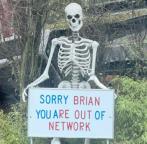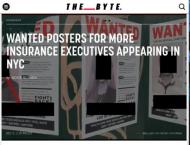American Executives Are Facing Unprecedented Security Threats
The outcome of this case will likely have significant consequences for the healthcare industry, executive security protocols, and broader societal understanding of violence and radicalization.
Author: Anthony Caudle – CEO
The healthcare industry is facing a new and alarming threat: Widespread and highly publicized targeted violence against its leaders 1. In the wake of the tragic assassination of UnitedHealthcare CEO Brian Thompson, a wave of threats has emerged, raising concerns about the safety of healthcare and other executives across the nation. This newsletter delves into the details of this disturbing trend, explores the broader implications for corporate America, and outlines the critical steps corporate America must take to protect its leaders and their organizations.
The Assassination of Brian Thompson and the Aftermath
 On December 4, 2024, Brian Thompson, the CEO of UnitedHealthcare, was fatally shot outside the New York Hilton Midtown hotel where he was to attend an investor meeting1. The assailant described as a white male wearing a mask, waited for Thompson and shot him multiple times before fleeing the scene1. Thompson was rushed to Mt. Sinai Hospital but later succumbed to his injuries2. This targeted attack sent shock waves through the healthcare industry and beyond2.
On December 4, 2024, Brian Thompson, the CEO of UnitedHealthcare, was fatally shot outside the New York Hilton Midtown hotel where he was to attend an investor meeting1. The assailant described as a white male wearing a mask, waited for Thompson and shot him multiple times before fleeing the scene1. Thompson was rushed to Mt. Sinai Hospital but later succumbed to his injuries2. This targeted attack sent shock waves through the healthcare industry and beyond2.
Law enforcement authorities acted swiftly, and on December 9th, 2024, a suspect, 26-year-old Luigi Mangione, was apprehended and charged with murder in connection with Thompson’s death3. While the arrest brought a sense of closure, it also unveiled a disturbing undercurrent of public sentiment. The public’s response to the tragedy was divided, with some expressing sympathy for Mangione’s perceived grievances against the healthcare industry and corporations in general4. This reaction highlighted the assassination as a potential manifestation of widespread anger and frustration directed at the insurance industry 4.
NYPD Response and Escalating Threats
In response to the assassination and the subsequent threats, the New York City Police Department (NYPD) issued an urgent call for heightened security measures across all industries 1. This call to action specifically emphasized the need for increased vigilance in high-profile and sensitive sectors like healthcare, where executives are particularly vulnerable1. The NYPD bulletin drew attention to a concerning trend on social media platforms, where some users expressed support for the violence against Thompson and even encouraged similar actions against other executives1. This online activity underscored the seriousness of the threats and the potential for further escalations.
Doxing, Targeted Harassment, and Violence Towards Corporate Executives
Following the assassination of Brian Thompson, a concerning trend has emerged involving doxing, targeted harassment, and the threat of violence towards corporate executives, particularly in the healthcare industry. According to a government intelligence report, there has been a surge in online activity expressing support for the attack and encouraging similar actions against other CEOs. This includes spreading “hit lists” on social media referencing specific executives from various industries, including healthcare, manufacturing, technology, and energy. Extremist groups have also expressed support for the killing, with some advocating for further violence against corporate leaders4.



The report highlights several instances of vandalism and bomb threats directed at healthcare executives and facilities. Unfounded bomb threats were reported at Brian Thompson’s home and a Connecticut municipality, referencing his killing4. Additionally, there have been reports of graffiti with threatening messages and social media posts encouraging violence against CEOs4.
While there are no specific or credible threats to executives in the Philadelphia regional area at this time, the report warns that the assassination may inspire extremist groups and individuals with anti-capitalist or accelerationist beliefs to carry out further acts of violence.
Key recommendations given in this report are:
- ● Executives should proactively review personal and professional social media pages to verify what information is publicly viewable. They should consider removing unnecessary information, such as residence history, hometown, and family information.
- ● Set privacy settings on social media pages to the most restrictive settings available. Ensure that identifying information that could be used to determine residences and family affiliations is only viewable by trusted friends and followers, and never share locations.
- ● Review what personal information is available on public data collection sites and request removal. Commonly utilized sites include BeenVerified, Spokeo, TruthFinder, True People Search, Intelius, MyLife, Radaris, Whitepages, US Search, Checkmate, and PeopleFinders.
Potential Threats Identified Following the Assassination
A recent analytical report from New York highlights the potential for copycat attacks, increased online threats of violence, and doxing incidents directed at high-profile corporate employees and public leaders5. The report expresses concern about the growing online support for the alleged shooter and the negative sentiment toward healthcare executives and health insurance companies.
The report also points to the risk of extremists viewing the assassination as an example to follow and the potential for cyberattacks and doxing targeting the healthcare industry, other corporate executives, and government officials. Doxing incidents involving UnitedHealth Group executives and online threats towards a former NYS Department of Health commissioner have already been observed5.
Broader Implications for American Executives
The threats against healthcare CEOs are not isolated incidents. They reflect a broader climate of hostility toward corporate leadership in America6. This climate is fueled by factors including rising economic inequality, growing public dissatisfaction with corporate practices, and political narratives that often demonize business leaders6.
This anti-corporate sentiment is not entirely new. Historically, there have been periods of public discontent with corporate power and influence in America7. However, the current climate is arguably more volatile, driven by social and economic anxieties and amplified by the rapid spread of information and misinformation through social media6. This environment demands that executives across all sectors recognize the heightened risks they face and take proactive measures to protect themselves and their organizations.
The implications are particularly significant for healthcare companies. As providers of essential services, they operate in a sector often at the center of public debate and scrutiny. Recent events demonstrate that healthcare leaders are now facing a new level of risk, and they must adapt their security strategies accordingly.
Duty of Care and Executive Protection
In light of these escalating threats, it is crucial to emphasize corporations’ duty of care towards their employees. This duty of care requires companies to take all reasonable steps to ensure the safety and well-being of their employees, including protecting them from potential harm [19,
26]. This responsibility extends to all employees, but it is particularly critical for high-profile executives who may be at increased risk of targeted violence.
Providing protection from harm is arguably the most important aspect of a corporation’s duty of care16. This includes implementing comprehensive security measures to safeguard executives from physical threats, cyber threats, and reputational risks17. Executive protection plays a crucial role in an organization’s risk management strategy by mitigating potential threats and ensuring the safety of key personnel18.
Corporations, whether in healthcare or other controversial economic sectors, must begin incorporating executive protection into their enterprise risk management models19. This involves conducting thorough risk assessments, evaluating existing security measures, and developing
strategies to mitigate identified risks. By prioritizing executive protection, companies can demonstrate their commitment to employee safety and fulfill their duty of care proactively and responsibly.
The Cost of Security
The increasing threat level against healthcare executives has led to a significant rise in security spending. Companies are investing more in physical security measures, cybersecurity defenses, and executive protection services to mitigate the risks 14. According to recent data, the median payment for personal security for CEOs in Fortune 500 companies has doubled over the last
three years14. This trend highlights the growing financial burden of security in the current climate. However, when it comes to corporate governance, the safety of a company’s leadership is as important as its financial strategy19. The ability of a CEO to lead effectively has a direct impact on the success of the organization. If a CEO’s security is compromised, the entire company can face significant consequences, including declines in stock value, reputational harm, and even legal liabilities. The true cost of failing to invest in CEO security for U.S. corporations’ executive leadership can be immeasurably damaging to the company’s bottom line.
Immediate Steps for Enhanced Personal Security
While comprehensive security programs are essential, executives can take immediate steps to improve their personal security in the face of these heightened threats:
- 1. Vary routines: Avoid predictable patterns in travel routes, schedules, and modes of transportation8. This includes varying the types of vehicles used and the times of day that travel occurs.
- 2. Enhance home security: Lock doors and windows to ensure residences are secure, and consider implementing additional security measures such as alarm systems, surveillance cameras, and reinforced entryways.
- 3. Maintain situational awareness: Be vigilant and aware of surroundings when traveling and in public spaces. This includes being aware of people following you or paying unusual attention to your movements.
- 4. Limit personal information online: Review and restrict access to personal information on social media and public data collection sites4. Consider removing unnecessary information, such as residence history, hometown, and family information.
The Role of Social Media
Social media platforms have played a significant role in amplifying anti-corporate sentiments and potentially contributing to the escalation of threats against healthcare executives6. The viral TikTok video showcasing the threatening posters is a prime example of how quickly and widely such messages can spread online, potentially inciting further hostility and violence1.
The online environment can also serve as an echo chamber for extremist views and violent ideologies, creating a sense of validation and encouragement for individuals who may be inclined to act on their anger and frustration1. This highlights the need for increased monitoring of social media platforms and proactive measures to counter the spread of harmful content.
Why Healthcare Companies Must Act Now
Healthcare organizations are at a crossroads. The assassination of Brian Thompson and the subsequent threats have exposed a critical vulnerability in the industry. CEOs and their companies must acknowledge the severity of these threats and take decisive action to protect their leaders, employees, and operations. Failing to do so endangers lives and risks further erosion of public trust in the industry.
Security Measures for Healthcare Executives

Healthcare companies are implementing a multi-layered approach to security, combining physical, cyber, and personal protection measures to mitigate the risks their CEOs face9. This shift in perspective reflects a growing recognition that CEO security is no longer just about protecting individuals but also about safeguarding the stability and reputation of the organizations they lead.
Some of the key security measures being implemented include:
- 1. Enhanced Physical Security: This includes increased security personnel at corporate offices and executive residences, stricter access control to executive suites and sensitive areas, and security technologies like surveillance systems, alarm monitoring, and reinforced walls and ceilings to prevent unauthorized access.
- 2. Cybersecurity Measures: Healthcare companies are bolstering their cybersecurity defenses to protect against cyberattacks and data breaches that could compromise sensitive information and potentially endanger executives10. This includes implementing multi-factor authentication, providing ongoing cybersecurity training for employees, and using encryption technology to protect data.
- 3. Executive Protection Teams: Some companies are establishing or expanding executive protection teams to provide specialized security services for their CEOs11. These teams conduct threat assessments, provide personal protection, and manage travel security to ensure the safety of CEOs in various situations.
- 4. Residential Security: CEOs’ homes are also being secured with safe rooms, reinforced entryways, and remote monitoring services to ensure their safety even when not at work.
- 5. Third-Party Security Assessments: Companies are increasingly turning to third-party security firms to conduct comprehensive assessments of their security operations and identify vulnerabilities. These assessments help ensure that security measures are robust, up-to date, and aligned with industry best practices.
Enhanced Patrol: A Leading Security Provider
Enhanced Patrol is a leading provider of professional security solutions with expertise in executive protection services14. They offer a comprehensive suite of security solutions tailored to the specific needs of healthcare organizations and their executives, including:

1. Executive Protection Services: Enhanced Patrol provides highly trained and experienced executive protection personnel to safeguard CEOs and other high profile individuals from potential threats. These services include close protection, threat assessments, travel security, and residential security, utilizing specialized vehicles with advanced security measures for safe and secure transportation.
2. Threat Assessment Services: Enhanced Patrol conducts comprehensive threat assessments to identify and evaluate potential risks to executives and organizations. These assessments consider various factors, including the individual’s profile, travel patterns, and the current threat environment, and utilize a structured process to determine the likelihood of targeted violence.
3. Security Assessment Services: Enhanced Patrol offers security assessments for homes, offices, and existing security measures to identify vulnerabilities and recommend improvements. These assessments help ensure that security protocols are robust and up-to-date, considering factors such as local demographics, terrain, and historical security incidents.
Conclusion: A Call to Action
The assassination of Brian Thompson and the subsequent public threats against healthcare executives have served as a wake-up call for the industry. The healthcare sector faces unprecedented security challenges in a climate of heightened hostility toward corporate leadership. This newsletter has explored the nature of these threats, the broader context in which they occur, and the critical security measures that healthcare companies are taking to protect their leaders and organizations.
The key takeaways are clear:
- ● The threat is real and growing: Targeted violence against healthcare executives is a serious concern that cannot be ignored.
- ● A multi-layered approach is essential: Effective security requires a combination of physical, cyber, and personal protection measures.
- ● Proactive measures are crucial: Companies must take a proactive approach to security, conducting risk assessments, implementing robust security protocols, and staying ahead of emerging threats.
The time for complacency is over. To navigate these turbulent times, healthcare companies must prioritize security and transparency. By taking decisive action to protect their leaders, employees, and operations, they can mitigate risks and ensure continued stability and trust in the healthcare industry. Enhanced Patrol offers the expertise and resources to help healthcare companies implement effective security measures and stay ahead of emerging threats.
Visit www.enhancedpatrol.com today to learn more about how your company can enhance its security posture.
Works Cited
- 1. Killing of Brian Thompson – Wikipedia, accessed December 13, 2024, https://en.wikipedia.org/wiki/Killing_of_Brian_Thompson
- 2. UnitedHealthcare CEO Brian Thompson Killed in Targeted Attack | Docwire News, accessed December 13, 2024, https://docwirenews.com/post/unitedhealthcare-ceo-brian-thompson-killed in-targeted-attack
- 3. Who was Brian Thompson, the UnitedHealthcare CEO shot dead in Manhattan?, accessed December 13, 2024, https://www.cbsnews.com/news/brian-thompson-unitedhealthcare-ceo manhattan-shooting/
- 4. Key details about the man accused of killing UnitedHealthcare’s CEO – AP News, accessed December 13, 2024, https://apnews.com/article/unitedhealthcare-ceo-brian-thompson-shooting-79a9710978fc7adbb23d3fed4ea2f70d
- 5. What Does Duty of Care Mean in Business and Financial Services? – Investopedia, accessed December 13, 2024, https://www.investopedia.com/terms/d/duty-care.asp
- 6. CEOs Under Siege: The Alarming Rise of Anti-Corporate Sentiment and Violence, accessed December 13, 2024, https://www.ceotodaymagazine.com/2024/12/ceos-under-siege-the alarming-rise-of-anti-corporate-sentiment-and-violence/
- 7. A Very Un-American Response to the Murder of Brian Thompson | Yale Insights, accessed December 13, 2024, https://insights.som.yale.edu/insights/very-un-american-response-to-the murder-of-brian-thompson
- 8. Companies tighten security after a health care CEO’s killing leads to a surge of threats, accessed December 13, 2024, https://www.ctpost.com/business/article/companies-tighten security-after-a-health-care-19976027.php
- 9. After UnitedHealthcare CEO’s killing, conversations around security are changing, accessed December 13, 2024, https://www.chiefhealthcareexecutive.com/view/after-unitedhealthcare-ceo s-killing-conversations-around-security-are-changing
- 10. Effective Security Measures for Healthcare Organizations – Clearwater, accessed December 13, 2024, https://clearwatersecurity.com/blog/6-security-measurement-best-practices-every healthcare-organization-should-know/
- 11. Hospital leaders must protect themselves from threats of all kinds | Viewpoint, accessed December 13, 2024, https://www.chiefhealthcareexecutive.com/view/hospital-leaders-must protect-themselves-and-their-organization-viewpoint
- 12. 11 Cybersecurity Best Practices for Healthcare Organizations …, accessed December 13, 2024, https://www.dataprise.com/resources/blog/healthcare-best-cybersecurity-practices/
- 13. CEO Safety Should Be a Top Concern for Boards: The Essential Role of Executive Protection – MPS Security, accessed December 13, 2024, https://security-mps.com/ceo-safety should-be-a-top-concern-for-boards-the-essential-role-of-executive-protection/
- 14. Healthcare & Hospital Security Services – Allied Universal, accessed December 13, 2024, https://www.aus.com/industry-expertise/healthcare
- 15. Executive Protection Services | VIP and Personal Protection Officer – Allied Universal, accessed December 13, 2024, https://www.aus.com/security-services/enhanced-protection services/executive-protection
- 16. What is an Executive Protection Agent and How They Operate – Dahlcore Security Guard Services, accessed December 13, 2024, https://dahlcore.com/blog/f/what-is-an-executive protection-agent-and-how-they-operate
- 17. CP3 Prevention Resource: Enhancing Behavioral Threat Assessment and Case Management Capabilities Through a Public Health-Informe – Homeland Security, accessed December 13, 2024, https://www.dhs.gov/sites/default/files/2024-08/2024_0821_cp3_- prevention-resource-btams.pdf
- 18. Enhanced Protection Services – Allied Universal, accessed December 13, 2024, https://www.aus.com/security-services/enhanced-protection-services
- 19. Security Services: Risk Assessment for Vehicle Patrols – XPressGuards, accessed December 13, 2024, https://xpressguards.com/security-services-risk-assessment-for-vehicle patrols/
